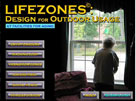| Elderly residents of long-term-care
facilities may long to go outdoors, but the designs of their new homes
do not always
make that easy. Now, a Texas A&M University architecture
professor is developing a multimedia guide to help designers
of nursing homes and assisted-living complexes build environments
that help residents enjoy nature.
"
Research in architecture and landscape design has revealed that
professionals in these fields don't always know how to build
elderly-friendly features that make the grounds of long-term-care
facilities accessible to their residents," says Susan Rodiek,
who is associate director of the Center for Health Systems & Design
(CHSD), a joint research center of the College of Architecture
and the Texas A&M System Health Science Center. "So
several colleagues, including CHSD Fellows Elton Abbot and Marcia
Ory, and I decided to put together a series of CDs showing them
how."
The interactive, multimedia series is called "Lifezones
for Aging: Design of Outdoor Space in Long-term-care Facilities." Funded
by SBIR grant #1 R43 AG024786-01 from the National Institute
on Aging (NIA), a division of the National Institutes of Health
(NIH), the series will detail research and best-practice design
guidelines in an easy-to-grasp format for busy architects, landscape
designers, construction professionals, and facility owner/operators.
"
Busy professionals are not reading the materials on this subject
which are already available," Rodiek says. "This CD
series uses multimedia to present the most important points in
short, easy-to-understand, interactive format. That way, people
who use the CD can repeat information as necessary or get more
information by accessing the embedded resources or the Web links
included with each presentation."
Rodiek, Abbot, also an architecture professor, and Ory, a professor
at the School of Rural Public Health, have finished the first
CD, "Outdoor Space for Aging," and have applied for
additional NIA funding to complete the series, which they estimate
will cover five to seven additional relevant design topics.
"
Making the first CD was Phase One of our project," Rodiek
says. "We sent the draft version for review to 100 industry
leaders, including government policy planners, executives of
healthcare provider organizations, practicing architects, architecture
professors and officers of voluntary organizations like the AARP.
They evaluated the lesson and told us they liked it learned from
it. We received high scores from all of them on learning-value,
enjoyment and usefulness, and 23 of them wrote letters of recommendation
for our application for continued funding.
" We are committed to improving the health of people who live in
long-term-care facilities by making research findings available
to those who design such facilities and their environments. We
see our work as building a bridge between academic research and
real world practice. Right now, there's nothing quite like this
series of interactive CDs in existence.
| |

"Lifezones for Aging: Design of Outdoor Space in Long-term-care
Facilities" (screenshot)
|

